Engineering ROI: Why Hiring a Third-Party Engineering Firm Pays Off
February 21, 2023

For McFadden Engineering clients, hiring a third-party engineering firm offers benefits that increase the overall return on investment (ROI) for the project. Not only do our clients receive additional assistance meeting deadlines and completion timelines, but the knowledge, experience and broad range of specialty services that MEI offers provides insight that turn issues into solutions. McFadden specializes in providing efficient, responsible and cost-effective solutions. Our team of engineers is multi-skilled and multi-disciplined and works closely with our clients to solve environmental and civil engineering challenges.
Receive an Outside Perspective
Too often, teams are focused on completing a project or identifying one solution and may lose perspective regarding solution effectiveness, recent innovations and long-term problem identification. Turning to a trusted outside engineering firm will bring a fresh perspective and an experienced team to your project. Sometimes even the simplest problems may go unidentified and cause unwanted surprises once the project is complete. Bringing in an outside perspective can often uncover issues with your project that your team never considered or does not have experience addressing.
Work with Specialists
Sometimes you need a specialist to design or work on a small aspect of your engineering project. While it may not make sense to bring them on for the entire project, hiring an engineering specialist for contractual work can give you the results you need while saving your project money. McFadden Engineering has experience working with other professionals to address specific aspects of projects such as NPDES permitting, wastewater treatment or meeting water reuse requirements. McFadden Engineering’s team of professional engineers and professional geologists solve unique challenges through an integrative and innovative approach to environmental and civil engineering. Our team understands advancing technologies and changing regulatory landscapes and works diligently to employ cost-effective and technically proven solutions.
Strategic Partnerships
Engaging with McFadden Engineering as a third-party engineering service also brings relationships with a large spectrum of companies and equipment suppliers. We have relationships with strategic partners that your company may not have and are able to leverage these relationships to help our clients meet timelines and navigate permitting and regulatory challenges.
When your project’s success and more importantly, ROI is at stake, trusting an experienced engineering partner is non-negotiable. Contact McFadden Engineering and our team of professional engineers and geologists to evaluate and solve your civil and environmental engineering issues. Learn more about our breadth of engineering services and contact us for more information.
McFadden Engineering Civil and Environmental Engineering Services Overview
January 20, 2023

As a new year begins, it’s important to regroup and take stock of the services we offer and the impact we have helped our clients make in the community. McFadden Engineering is a 35-year-old firm, that provides environmentally sound solutions to solve the unique engineering needs of our clients. We are licensed to serve clients in Alabama, Florida, Georgia, Louisiana, Mississippi and Tennessee. Our technical staff has a cumulative 120 years of experience solving water and wastewater problems.
Civil Engineering and General Services
McFadden Engineering offers civil engineering services to commercial and industrial clients of all sizes. With a multi-disciplinary approach, we offer services such as development master planning, grading and drainage plan development, detention and retention design and stormwater management.
Read more about our work with Mobile Memorial Gardens.
Site Assessment and Remediation
McFadden Engineering is a leader in providing timely environmental site assessments to determine the existence of any environmental liabilities. Professional assessments include assembling public site records, leading physical site inspections, conducting interviews and performing additional steps as requested by the client, all conducted in accordance with established ASTM guidelines. Should an initial assessment reveal environmental problems, McFadden Engineering has the expertise to aid in conducting further investigation of the site (Phase II Site Assessment) as well as determining and implementing appropriate solutions.
Read more about our site remediation work at a manufactured gas plant facility.
Environmental Engineering Services
McFadden Engineering provides general environmental engineering services aimed to protect the environment from the impact of both natural and human activities. Our broad environmental engineering experience includes the development of best management practices for facility compliance, spill and response plan development for industrial clients and determining treatment alternatives for meeting permitted discharge limits.
Read more about our permit work with Master Boat Builders.
Environmental Compliance
McFadden Engineering has excellent established relationships with local, state and federal regulatory agencies and navigates the regulatory environmental permitting process on our client’s behalf, saving time and capital. Performing compliance audits for our clients assists them in meeting legal obligations for environmental performance.
Learn more about NPDES permits and the clients we assist with their ongoing permit compliance.
Water Quality and Hydraulic Modeling
McFadden Engineering has been on the leading edge of water quality modeling for more than 30 years, helping to develop some of the first water quality models used by the Alabama Department of Environmental Management (ADEM). Water quality modeling can be used to estimate the environmental impact of factors such as wastewater treatment plant discharges, industrial activity and commercial site development.
Read more about our work on the restoration of New River Bayou and its overall impact on Lake Pontchartrain.
Water and Wastewater Treatment
McFadden Engineering has extensive experience in managing drinking water and wastewater treatment. As a leader in water and wastewater process design in the Southeast, we deliver innovative systems to solve the most challenging problems. McFadden Engineering believes that by evaluating the water and wastewater needs of the client, a solution can be developed that specifically addresses the problem. No two clients are the same and our innovative approach to providing solutions expands our clients’ operational flexibility and allows for future growth.
Learn more about our work with Attalla Water Works Board (AWWB) to expand and upgrade its water treatment facility in Etowah County, Alabama.
Industrial Wastewater Treatment
Our goal for industrial wastewater treatment clients is to streamline treatment processes, achieve full compliance and ultimately reduce or eliminate surcharges and extra costs incurred from not meeting permit limits.
Read more about working with an Alabama poultry processing plant to solve their wastewater discharge issues.
Facility Management and Operations
McFadden Engineering offers facility management and operation services to ease the burden our clients face when tasked with maintaining general facilities and wastewater treatment operations for their organizations.
Our experienced Class 4 Wastewater Operator and engineering staff offer training, maintenance and full facility management to customers with small to medium flow wastewater systems, including schools, college campuses and small municipalities. We understand these organizations may not have a wastewater operator on staff, which is when McFadden’s team can step in and address those needs. McFadden Engineering can assess and maintain existing wastewater treatment operations and can also offer training and new management solutions for operators who may face recurring challenges on the job.
Learn more about our weekly management of the University of Mobile wastewater treatment system.
Contact McFadden Engineering and our team of professional engineers and geologists to evaluate and solve your civil and environmental engineering issues.
Top 3 Retention Tips Engineering Employers
December 19, 2022

In 2018 a detailed overview prepared by Deloitte, the number one accounting firm in the world, revealed a lack of skillful engineering specialists in the manufacturing industry. As engineering talent continues to be more difficult to find and retain, organization’s face uncertainty in managing future challenges. It is estimated that up to 2 million positions will be left unfilled over the course of the next few years. The key to success lies in retaining current and future engineering talent that are currently in the organization. McFadden Engineering has reviewed and created a list of our top retention practices we employ and are eager to share these practices with future team members and others in the engineering industry.
Prioritize Retention
Although it is seemingly common sense, it is not always easy to prioritize retention within an organization. A large percentage of recruiters in the engineering industry found the shortage of engineering skills has negatively impacted the hiring process and is becoming a complex challenge. With this challenge comes the opportunity to reflect on your organizations internal status and focus on optimizing partnerships with your technical staff. This is a great way for employers to retain their top professionals and work through any industry challenges that may arise.
Prioritizing implementation of retention practices in your organization will generate positive outcomes for current and future employees. Actively showing employees they are genuinely cared for as a team member drives a deeper passion for hard work to achieve overall success and growth of a company.
Upskilling
Upskilling is providing team members with learning and skills development opportunities. This has become an essential retention practice for McFadden Engineering and is an optimal way to solve the problem of limited engineering skills. In 2019, Glassdoor conducted interviews with engineers to uncover what they appreciated most in an employer. Results showed a diverse training program was one of the things they valued the most. Largely due to the time invested in implementing training , employees feel as the company is dedicated to continuously improving company culture. Utilizing upskilling practices can incentivize engineers to shift their focus on skill development which will also progress their careers. In return, upskilling helps employers develop potential leaders within the organization while creating employee loyalty.
Pay Attention to Personality Types
In the engineering industry, having a diverse workplace is crucial for the creation of efficient ideas and solutions. However, it is important to harness diversity for your organization’s benefit. The first step in managing your company’s diversity is focusing on establishing a working relationship with each member of your engineering team. This allows you to get to know each employee and gain insight to how they work. Creating meaningful work relationships proves to employees that they are valued and play an important role in the company. Understanding the dynamic of a team and recognizing each member’s areas of expertise is critical in maintaining a strong group mentality.
Employers should find time to observe team interactions and the personality types present in the workspace. Observations will most likely show a mixture of personalities with some employees demonstrating dominance when communicating (extroverts) while others display a reserved demeanor and rarely initiate conversations with colleagues (introverts). Once team diversity is recognized, it is our job to help facilitate an environment where both personality types possess equal opportunities to express their points of view. When retaining introverts, you should encourage them to speak up so they know their ideas and contributions are welcomed and appreciated. Extroverts typically have no problem saying what is on their mind. In this case, the task is to challenge them to contemplate more and encourage them to pause before speaking, which will create a more balanced dialogue within the organization.
At McFadden Engineering, our team of talented engineers and geologists have more than a century of combined civil and environmental experience. Our company is a combination of personality types working together to generate environmentally sound solutions to water and wastewater problems. To learn more about our work, give or become a team member give us a call at 251-470-6870.
Low Flow Groundwater Sampling – The Industry Standard
November 22, 2022

The methods and objectives of groundwater sampling to assess water quality has evolved. Why do we sample groundwater? Typically to access environmental impacts to soil and groundwater from chemicals of concern (COCs) or volatile organic compounds (VOCs).
This can be a challenging task for geologists and engineers and one that is not always easily accomplished. Since the mid-1990s, low-flow sampling has become an increasingly popular method for obtaining high-quality groundwater samples and has become the established method for providing the most accurate groundwater sampling data for assessment purposes.
Traditional Groundwater Sampling
Before low-flow sampling technologies were implemented, the most common groundwater and sampling methodology were to purge a well using bailers or high-speed pumps. This method involved removing three to five casing volumes and following up with a sample collection. This more traditional method can have adverse impacts on sample quality and has the potential to produce an overestimation of certain metals or organic compounds. Through the work of Robert W. Puls and Michael J. Barcelona, in 1996 the United States Environmental Protection Agency (USEPA) released standard operating procedures for low-flow sampling. Following such guidelines ensures the collection of samples that are representative of water conditions.
Low Flow Purging and Sampling Procedures
Low-flow purging and sampling involve extracting groundwater at rates typically less than 500 ml/min so that the drawdown of the water level is minimized. This method reduces the mixing of stagnant groundwater with groundwater from the screened intake area which ensures the sample is more representative of the aquifer conditions.
The sampling process involves collecting the depth of groundwater in each monitoring well so groundwater elevation can be established for that specific location. This sampling process plays a key role in ensuring that the evacuation rate from the monitoring well is properly adjusted and maintained during the purging and sampling process. Before the sample is collected, the stabilization of water quality parameters such as pH, DO, conductivity, temperature, oxidation-reduction potential and turbidity of the purged water is monitored. By allowing the aquifer to equilibrate before sampling, low-flow methods produce samples that are representative of the formation water.
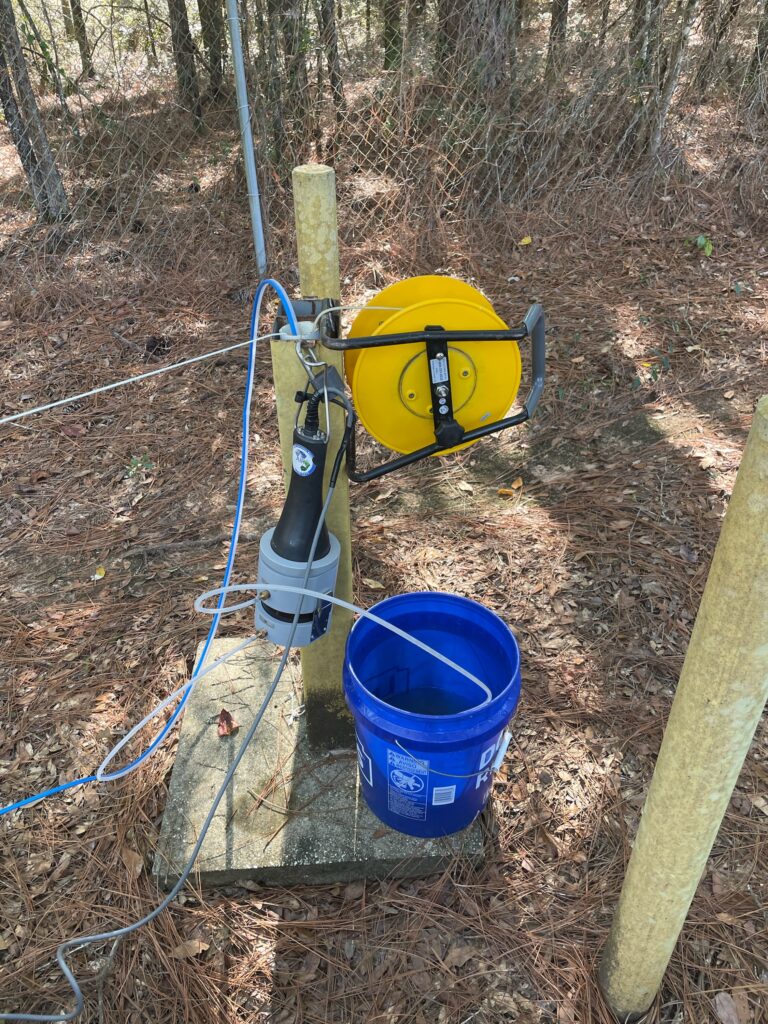
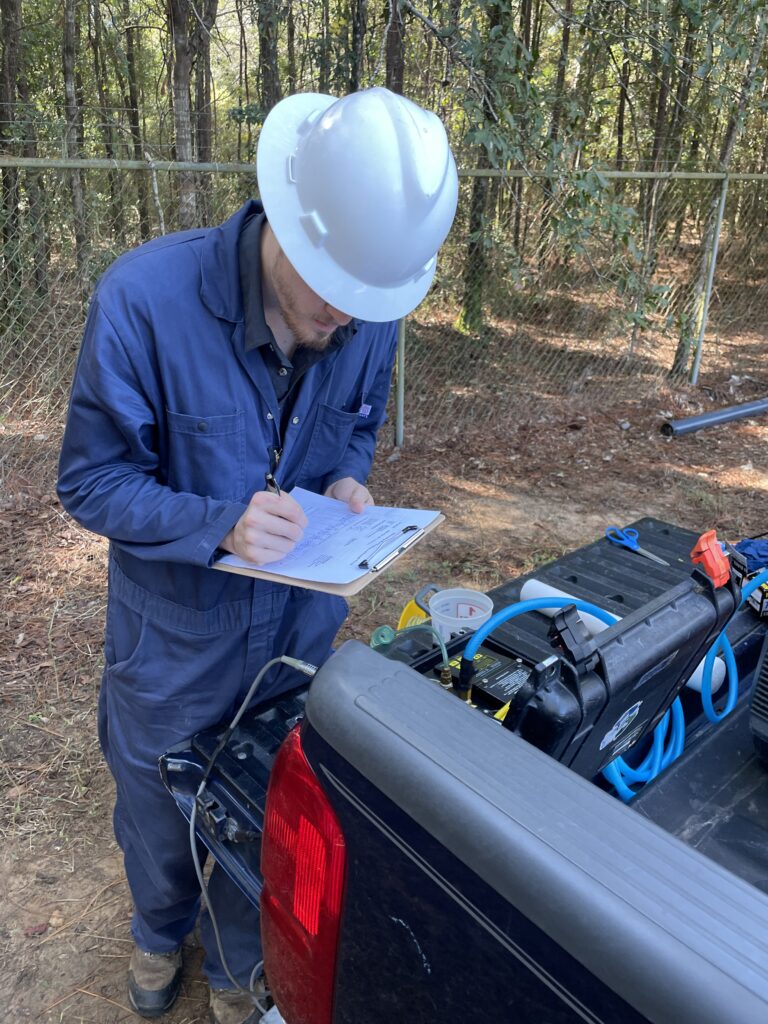
At McFadden Engineering, we implement the most effective and accurate environmental testing and solutions to water and wastewater problems, which is why we utilize low-flow purging methods on a variety of projects. To learn more about our work with low-flow purging, visit the links below or give us a call at 251-470-6870 or send us an email.
Rain Drop Car Wash Installs McFadden Engineering’s OxyShark® Water Reclamation System
October 27, 2022

OxyShark® Water Reclamation (OWR) is a wastewater treatment system used to treat domestic, commercial and industrial wastewater. OxyShark utilizes a high-rate biological process specially designed to produce reusable, nearly potable clean water.
Founded by a team of experienced water engineering professionals with a background in wastewater process design, OxyShark is a leader in the wastewater treatment world, distinguished by its speed and efficiency in completing the treatment process up to 10x faster and with a smaller footprint than traditional systems.
Car Wash Training Facility in Clay, AL
A customer came to the OxyShark team with a proposed car wash and car wash training facility in Clay, AL. The main challenge of this location was the lack of sewer connections in which to discharge wastewater. The expected capacity was 7,500 gallons per day (GPD) of car wash water generated at the site. Following a thorough design process, a two-unit system was designed and installed featuring Zeolite filtration and a 10,000-gallon equalization (EQ) tank. The large EQ tank was necessary to handle any temporary surges since there was no available sewer discharge connection. The customer’s goal was 100% water reuse less the approximate 17% losses due to evaporation and drive-off.
OxyShark also allows for a small city water usage at the car washes’ reverse osmosis filter for a spot-free rinse and an automatic city water make-up valve installed on the reclaim tank to replace water lost to drive off and evaporation.
From day one, the system exceeded expectations, as the customer is averaging 10,000 GPD due to a higher-than-expected traffic count. The system was able to increase the average flow through the OxyShark system beyond the design point to meet the increased demand. The customer reports clean water with no odor, good wash quality and efficient use of chemicals. Every three to four months, the McFadden team will purge the system with a small volume of city water. This helps reduce the build-up of dissolved solids in the reclaim water. Other than this quarterly purge and the small amount of spot-free rinse water, the system is 100% reclaim. The OxyShark microprocessor based 100% reclaim wash water system proved to be the best solution for this challenging car wash project.
In addition to this unique car wash application, OxyShark has proven to be an efficient treatment technology in many other commercial and industrial applications. If you are interested in learning more about potential applications for OxyShark treatment technology and the capabilities of our system, contact us at 251-470-6870 or visit our website. We look forward to working with you on any future potential projects.


Disinfection Options in the Wastewater Engineering Process
September 21, 2022
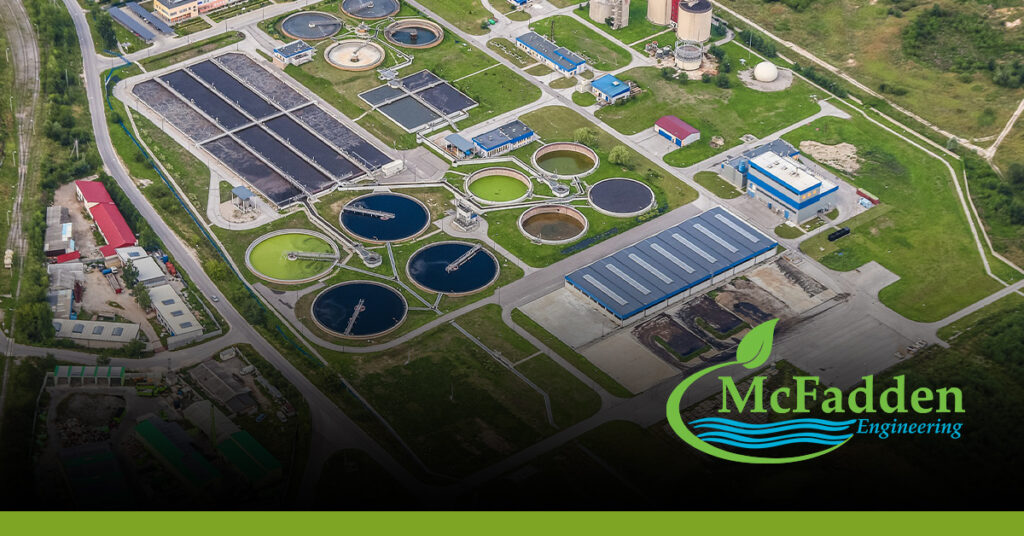
Chlorine, Ultraviolet and Ozone
McFadden Engineering is known across the Southeast for providing environmentally sound wastewater treatment solutions. Over the last 30 years, a large majority of our projects have included solving wastewater related issues for our clients. Wastewater engineering, also known as sanitary engineering, is the use of treatment processes (biological, mechanical, or chemical) to treat water so that a high-quality water can be achieved and maintained in the effluent. It is a vital component in the protection of public health and the environment.
According to the United States Environmental Protection Agency (EPA), disinfection is the primary mechanism for the destruction of pathogenic organisms. The disinfection process prevents the spread of waterborne diseases to downstream users and the environment. Wastewater disinfection is a vital area within the treatment process because it assists in the prevention of diseases like salmonella, cholera and gastroenteritis. This article takes a deeper dive into various disinfection options with beneficial qualities including chlorine, ultraviolet and ozone.
How is Chlorine Used in the Disinfection Process?
Chlorine (Cl) is the most widespread disinfectant used for municipal wastewater because it destroys target organisms and has a long history of being an effective disinfectant. Chlorination is a commonly used chemical and has a flexible dosing control. There are multiple advantages to using chlorine as a disinfectant including;
- Cost-effectiveness
- Success in eliminating a wide spectrum of pathogenic organisms
- Being useful in oxidizing certain organic and inorganic compounds
- Success in eliminating certain noxious odors during the disinfection process that can cause physical discomfort to residents in adjacent areas
However, care must be taken when using chlorine. Some disadvantages to be mindful of include:
- Toxic gas and extreme corrosion
- Can produce Disinfection By-Products (DBPs) that can cause harm to humans and others living organisms
- Must be handled safely in proper doses
How is Ultraviolet Light Used in the Disinfection Process?
The EPA defines Ultraviolet (UV) disinfection as the transfer of electromagnetic energy from a mercury arc lamp to an organism’s genetic material. Disinfection happens when UV radiation penetrates the cell wall of an organism and destroys the cells’ ability to reproduce.
The benefits of disinfecting with UV radiation include:
- Highly effective in destroying most viruses, spores and cysts without using chemicals.
- No residual effect that can harm human or aquatic life and is a user-friendly operation
- UV radiation is also valuable because it is a physical process that eliminates the need to generate and transport hazardous or corrosive chemicals
Despite being highly effective, there are drawbacks when using UV for disinfection including:
- UV does not leave a residual in the effluent which can allow some of the pathogens to slip through the process in the effluent
- The use of light to decontaminate may render high concentrations of Total Suspended Solids (TSS)
- Pre-treatment efforts need to be vetted prior to the disinfection stage if TSS levels are anticipated to be higher than normal
- Photoreactivation has to be monitored to ensure no micro-organisms are able to repair themselves following the UV light Treatment
How is Ozone used in the Disinfection Process?
For ozone disinfection to occur, ozone (O3) must be produced. The EPA states that ozone is produced when oxygen molecules separate into oxygen atoms. The oxygen atoms collide with an oxygen molecule and form an unstable gas, ozone. Disinfection takes place when ozone decomposes in water and destroys bacteria with the help of hydrogen peroxide and hydroxyl.
Ozone treatment is a more effective option for disinfection than chlorine or UV, however, the capital costs are far greater than other disinfection options making it the least used disinfection method in the United States. Despite the cost disadvantage, there are other advantages to using ozone for disinfection including:
- Generated onsite resulting in fewer problems associated with shipping and handling
- No harmful residuals that need to be removed
- No regrowth of microorganisms, except for the ones protected in the wastewater stream
Similar to the other two options there are cons associated with ozone that include:
- Highly reactive
- Corrosive resistant materials must be used in the application
- Works best in applications where the effluent has been highly treated so that the residual pathogens are attacked and eliminated
Our team at McFadden Engineering has a combined 120 years of experience in solving water and wastewater problems. To learn more about our wastewater treatment projects visit our website or give us a call at 251-470-6870. We are eager to partner with you on your next project.
Top 3 Most Valuable Leadership Qualities for Engineers
August 19, 2022

Why Strong Leadership Is Beneficial in Engineering Services
Strong leadership and leadership development have become increasingly urgent for organizations across multiple fields. To survive and thrive in the constantly changing, complex, and often uncertain environment and economic climate, companies depend on strong leadership from within their organization to push through challenging circumstances and meet the needs of their clients.
In the field of engineering, leadership skills are extremely valuable. Instilling these qualities can impact the current and future successes of the employees and organization. While engineers across multiple disciplines are known to be strong competitors in math and science, there are additional skills that are beneficial to becoming a strong engineering leader. We’ve outlined the top 3 most valuable leadership qualities for professionals in the engineering field and why these skills are essential to continued growth and success and are pursued daily by the McFadden Engineering team.
#1 Collaboration
Engineering is an intricate field with projects that often require more than one person to complete the job. For a leader in the engineering profession, it is essential to know how to manage a team or department and promote a positive atmosphere for collaboration. The goal is to have a team that can work together and get the job done. Collaboration between leaders and employees is crucial to the overall success of projects and the organization.
Our team at McFadden values client participation. Our client/ consultant relationship builds a partnership that ensures a specific and complete solution that is designed to meet the distinct needs of a client or project. We do this by viewing our clients as a partner and by making connections. We are always eager to interact with new clients and assist them in achieving their goals.
#2 Communication
Being able to effectively communicate goals and strategies with their team allows leaders to create a positive workspace for everyone. Strong communication skills are also beneficial to engineering leaders because it enables leaders to share highlights and successes with other members of the organization.
At McFadden, our team of professional engineers and professional geologists have a wide array of knowledge in the field. We ensure strong communication is upheld by maintaining mutually beneficial relationships with clients and ensuring that they remain informed throughout each phase of the project. When working with clients, it’s imperative that leaders can communicate effectively and explain why certain strategies and solutions are being implemented throughout the project.
#3 Problem Solving Skills
Engineering is a discipline based on problem-solving and solutions. For leaders in engineering, utilizing problem-solving skills to tackle challenges from varying angles is vital for success. There are typically multiple perspectives to access a problem, but it is the job of the leader to investigate which solution is the most effective and for his or her team to succeed.
With a combined 120 years of experience, our team utilizes problem-solving skills to anticipate potential challenges and provide innovative solutions for our clients. Our goal is to work with our clients to provide environmentally sound solutions.
Strong leadership skills in engineering yield positive results for employees, organizations, and most importantly, clients. McFadden places a high value on instilling leadership qualities into our organization. Our leaders and team members consistently use collaboration, communication, and problem-solving skills to generate the best outcomes for clients. These leadership skills allow our team to succeed by helping our clients succeed.
Let us partner with you on your next project by contacting us at (251) 470-6870 or visiting the contact page of our website.
McFadden Civil Engineering Services: Detention and Retention Design
August 5, 2022
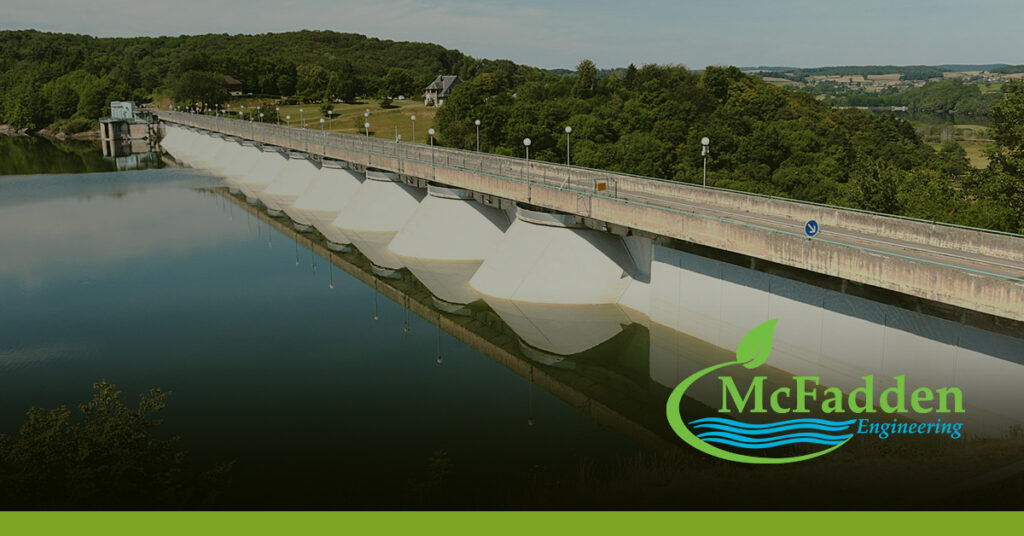
Determining the difference between detention and retention designs can be tricky. Both detention and retention systems involve methods of controlling flooding and erosion by managing quantities of water. Despite the similarities, the two are very different. In this blog, we discuss our experience with civil engineering services and provide the key differences between detention and retention designs.
Civil Engineering Services at McFadden
Our team at McFadden has a combined 120 years of civil and environmental engineering experience and has been delivering services to commercial and industrial clients in the Southeast for more than 30 years. We provide a broad range of services including master planning, site development, stormwater management and GIS development services. Our goals are to help our clients achieve regulatory compliance, reduce costs, solve complex problems and shrink the environmental footprint for each project we take on.
With a multi-disciplinary approach, we offer services such as development master planning, grading and drainage plan development, stormwater management and detention and retention design. Both detention and retention design are commonly used throughout civil engineering and water management and are even used together on projects like stormwater ponds. It is important to know what detention and retention are to properly determine the service needed.
Detention vs. Retention
Detention
Also referred to as dry ponds, detention ponds mainly offer flood control by controlling the rate of water flow. This is accomplished through a control device typically placed at the entrance to the outlet pipe that maintains the pre-development rate of flow. In both detention and retention design, determining volume of the pond is a key component. Volume refers to the amount of space needed considering the amount of water that the pond will need to hold. To calculate the volume, engineers like our team at McFadden, will compare the pre-development to post-development runoff volumes. The intended goal of a detention pond is to drain water within a certain amount of time to make volume (space) available for the next storm event.
Systems designed with an underdrain or outlet that slowly releases the water downstream are most likely detention systems.
Retention
In contrast to dry detention ponds, retention ponds are referred to as wet ponds. This is because a retention pond permanently holds the water. In some cases, the bottom of the retention pond is placed below the elevation (height) of the groundwater table to create a permanent pool of water.
The amount of water in this pond rises and drops through an outlet source depending on the runoff coming from contributing areas. Both detention and retention ponds are sized based on rainfall runoff and a desired release volume. For a retention pond in particular, the volume of the pond is determined by settling times for target pollutants and evaporation rates for the specific area. In addition, retention ponds allow the vegetation and microbes present to gradually consume nutrients and other pollutants.
Typically, retention ponds are designed to allow time for the sediment to settle to the bottom of the pond prior to the water exiting.
Our team of talented engineers has worked on a variety of projects involving detention and retention design. For example, in 2015 we designed and constructed a new detention pond to capture stormwater runoff from the parking area of Bay City Free Will Baptist Church (BCFWBC) located in Semmes, AL. More recently, McFadden Engineering was retained by Threaded Fasteners (TFI) to provide planning and engineering services for the expansion of its current operation by developing a portion of the 10-acre parcel for the construction of an additional facility for a galvanizing operation. Our team assisted TFI with site design and layout, grading and drainage design, and design of a detention facility that would allow for additional facility expansion. Our work helped ease the growing concerns of church staff and provided the upgrades needed to meet Mobile County, specifications. To learn more about our work with detention and retention designs, complete our contact form or contact us as 251-470-6870.
Related Stories:
Civil Engineering and General Services
Bay City Free Will Baptist Church Parking and Drainage Upgrade
Interested in learning about other services?
At McFadden, we use a holistic approach to provide a variety of engineering services that aim to meet the unique needs of our clients.
Wastewater Permitting Options in the State of Alabama
June 21, 2022
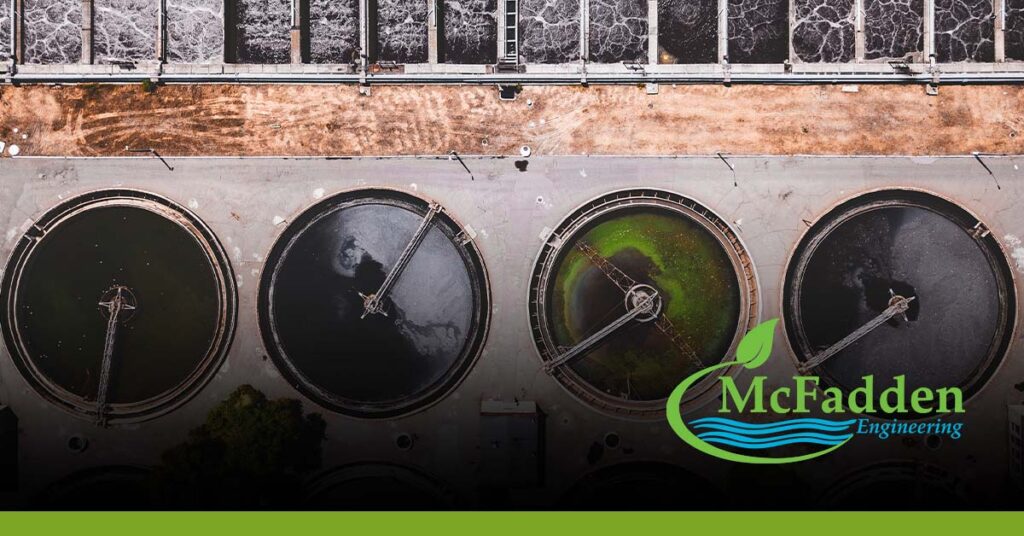
The major aim of wastewater treatment operations is to create safe water by extracting pollutants, removing contaminants and killing pathogens so that water reaches a permissible level of cleanliness to be discharged into nearby bodies of water and ecosystems. In addition to creating safe, reusable water, wastewater treatment facilities must follow regulations set at local, state and federal levels. The environmental permitting process can be tricky to navigate, as standards are always evolving. It can be hard for businesses to keep up.
In this blog, we discuss all the environmental permitting options for wastewater treatment facilities in the state of Alabama and how McFadden can help bridge the gap between your business and regulatory principles.
Water Reclamation in Alabama
The state of Alabama has two classes of reuse water: Class A and Class B. Water reuse can be defined as planned or unplanned and can provide alternatives to existing water supplies. In addition, water reuse applications can be used to ensure water security, sustainability, and quality. These two classes are defined as follows:
- Class A Reuse Water—Secondary treated wastewater that has, at minimum, received additional treatment and disinfection.
- Class B Reuse Water—Secondary treated wastewater that has, at minimum, been disinfected.
Class A and Class B water can be reused in numerous applications including the following:
- Fodder
- Fiber crops
- Ornamental nursery stock
- Sod and seed crops not intended for human consumption
- Pasture for animals not producing milk for human consumption
- Irrigation for golf courses
- Highway medians and roadside vegetation
- Cemeteries
- Other applications with ADEM approval
Options for Permitting Treated Wastewater Discharge in Alabama
According to federal guidelines, states can maintain primary regulatory authority by following these specific permitting ordinances:
- General NPDES
- Individual NPDES
- Underground Injection Control (UIC)
- State Indirect Discharge (SID) to POTW
- Onsite from ADPH
National Pollutant Discharge Elimination System (NPDES) Permit
The regulations and laws surrounding Alabama’s NPDES permit are in place to regulate point sources that discharge pollutants to waters of the United States. There are two NPDES permits that wastewater companies can acquire. These include:
General
- Permit based on activities at facility
- Permit limits are already published and established by regulators (i.e. non-negotiable)
- Enrollment through notice of intent process
Individual
- EPA Forms are required presenting expected effluent quality and treatment system
- Permit limits based on waste load allocation (WLA) for receiving stream
- Limits can be negotiated based on WLA results
Underground Injection Control (UIC) Permit
Any wastewater treatment facility that plans to inject fluid into the subsurface via an injection well must receive a UIC permit. A few keys to this permit are as follows:
- Requirement of land area with critical soils evaluation
- Permit limits are usually less stringent than a NPDES permit
- Subsurface Discharge
–Traditional disposal methods
–Injection wells
One aspect of this permit that should be noted is that the point of compliance for the permit is in the groundwater. Monitoring of groundwater for key parameters based on the characteristics of the waste stream will be required adjacent to the injection area. Also, plans should be made during the design process to limit public access to the application area.
State Indirect Discharge (SID) Permit
In the state of Alabama, a company is required to obtain an SID permit if they meet one or more of the definitions for an industrial discharger:
- Subject to categorical pretreatment standards
- Industrial discharges over 25,000 GPD
- Discharge makes up 5% or more of the flow to a POTW
- Any discharge that could potentially have an adverse impact on the POTW
Alabama Department of Public Health (ADPH) Permit
In the state of Alabama, the ADPH permit is required for onsite sewage disposal systems that fall into one of the following categories:
- Residential use
- Small flow commercial (<1,500 GPD)
These systems have very strict sizing guidelines set forth in the ADPH onsite disposal regulations. However, there is typically no monitoring of effluent or groundwater required for these systems.
Permit Evaluation
Before you start your next project, it’s imperative that you understand the regulatory process, treatment requirements and evaluate your ROI for treatment and disposal options. In addition, you must review typical monitoring requirements and permit terms to ensure your wastewater treatment facility operator:
- Reads and understands your permit requirements and keeps it accessible
- Expects regulatory visits
- Maintains documents and keeps good records
Taking time to perform basic housekeeping in your wastewater plant can save time and efficiency in the long run.
McFadden Engineering has established relationships with local, state and federal regulatory agencies and can help navigate the environmental permitting process on our clients’ behalf. Based in Alabama with licenses to operate in Georgia, Florida, Louisiana, Mississippi and Tennessee, McFadden Engineering can serve as the liaison between your business and wastewater the environmental regulators. Get in touch today to find out how McFadden Engineering can help solve your wastewater treatment facility’s permitting needs.
Process Optimization for Wastewater Treatment Facilities
May 25, 2022

Wastewater treatment plants include numerous individual treatment processes within the overall treatment train. Each of these individual processes have optimum operating conditions that allow them to efficiently handle the specific parameters which the process is designed to treat. The misalignment of one of these parameters can result in a treatment process that is costly and difficult to maintain. In a worst-case scenario, your wastewater process can fail completely––leading to environmental compliance issues and poor effluent water quality.
By optimizing your treatment system and the individual processes, users can achieve consistent regulatory compliance, save operators valuable time and reduce overall operational costs at the facility.
The First Stage of Process Optimization: Parameter Evaluation
The first part of wastewater treatment process optimization includes a thorough evaluation of the process parameters that affect your wastewater treatment process. These parameters include:
- Permitted discharge limits
- Influent and effluent water quality
- Source water make-up
- Chemicals used in the wastewater treatment process
- Chemical and physical water characteristics
- Upstream and downstream processes
- Wastewater generating activities
During this evaluation, our team of engineers and wastewater operators will assess lab data to detect how the plant is processing wastewater. In addition, necessary testing and analysis (such as jar testing, biodegradability, etc.) can be conducted to evaluate the performance of the individual processes in the wastewater treatment facility. This can help our operators determine if plant operators are taking the appropriate steps to improve the plant’s overall performance and output.
After we complete a thorough evaluation of your current process parameters, we can conduct an equipment analysis and test other components of your plant’s process.
The Second Stage of Process Optimization: Equipment Operation Analysis
A typical approach to equipment review involves three main objectives: conducting an equipment audit, identifying equipment issues, and developing a plan to address the identified equipment faults. When equipment is evaluated by our professionals, we most often look at the yearly maintenance schedule to determine if the equipment is operating at its optimum level. An equipment audit review is an integral part of any organization’s wastewater treatment plan. Our equipment review findings can give us a glimpse into your plant’s wastewater treatment facility process and identify ways we can implement, upgrade or benchmark your plant’s process optimization. Based upon our findings, McFadden Engineering can develop a plan for operational adjustments, equipment upgrades and new chemicals for the treatment process.
The Final Stage of Process Optimization: Assess Operation
Performance assessment is an integral tool for wastewater treatment plants to operate on a cost-effective and sustainable basis. After the necessary wastewater treatment facility parameters have been evaluated and an action plan has been developed and implemented to address the outstanding equipment needs, our team will assess the wastewater plant operation. This includes a thorough review of monthly reporting to regulatory agencies and daily lab data, if available. In addition, maintenance logs and equipment history are usually very helpful in evaluating issues. Our team will also develop a list of priorities to determine which plant objectives to tackle first. In some instances, recommendations could include additional site training for the facility’s operator and staff.
Throughout this process, it’s imperative that our operators maintain a pulse on your plant’s progress to ensure an efficient and smooth-running system operation.
Enhance Your Wastewater Treatment Plant’s Efficiency with On-Site Engineering Consultants
All wastewater treatment facilities strive to reach their maximum outputs, while maintaining a smooth-running operation. Despite your plant’s best efforts to maintain a well-oiled operation, sometimes optimization is needed to achieve maximum efficiency. Optimization can take many different forms – this could mean anything from hiring additional wastewater operators to incorporating additional treatment processes to meet the overall needs of the facility. Our team at McFadden has a collective 100 years of working in wastewater management. We’re here to serve as allies for your wastewater plant––to help your plant achieve efficiency and run better than before.
For more information about McFadden Engineering’s Facility Management and Operations services, contact us.